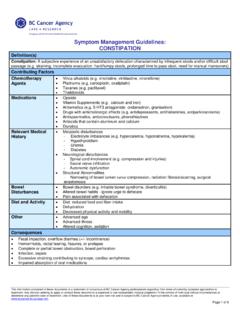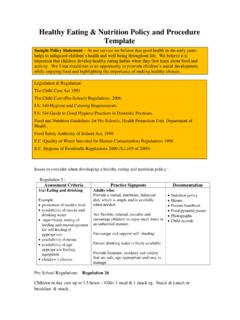Transcription of What is Histamine? - Food Allergy, Nutrition & Health ...
1 1 Vickerstaff Health Services Inc. Fact Sheet dietary management OF histamine INTOLERANCE What is histamine ? histamine is an extremely important bioactive chemical that is indispensable in the efficient functioning of many body systems. It is a neurotransmitter (a chemical that conveys messages between cells of the nervous system) and is involved in the regulation of stomach (gastric) acid, the permeability of blood vessels, muscle contraction, and brain function. histamine appears in various concentrations in a range of mammalian tissues. In humans, the highest histamine concentrations are found in the skin, lung, and stomach, with smaller amounts in the brain and heart. histamine is also essential in defending the body against invasion by potentially disease-causing agents such as bacteria, viruses and other foreign invaders.
2 histamine is made and stored within white blood cells (leukocytes) such as mast cells in tissues and basophils that circulate in blood. When the immune system is activated in response to foreign material entering the body, histamine is the first "defence chemical", or more correctly, inflammatory mediator, released in the process called inflammation. Inflammation is the clinical evidence that the immune system is responding. In addition to its role in controlling vital body processes and defending against foreign invaders, histamine is a key mediator in the symptoms of an allergic reaction. Since allergy is essentially an inflammatory reaction, histamine , together with other protective inflammatory mediators is released in response to the allergen. Allergens are components of living cells that in themselves are harmless, such as plant pollens, animal dander, mould spores, dust particles, dust mites and foods.
3 An allergic reaction to these "foreign but harmless" substances occurs when the immune system mistakes these innocuous materials for a potential threat. Where Does histamine Come From? Body Cells and Systems (Intrinsic histamine ) histamine is a biogenic amine (sometimes referred to as a vasoactive amine) that, in mammals, is produced primarily by the action of the enzyme histidine decarboxylase on the amino acid histidine. Histidine is one of the 20 or so amino acids that combine together to make a protein. Histidine decarboxylase is present in large quantities in leukocytes known as granulocytes (granule-containing cells), especially tissue mast cells and blood basophils. In these cells it converts histidine to histamine . The newly formed histamine is then stored in structures within the cell (called intracellular granules) in readiness for release in response to signals from a variety of body systems.
4 In inflammation, whether produced in defending the body from injury or infection, or as a result of an allergic reaction, these signals come from lymphocytes, cytokines and antibodies. However, this is not the only source of histamine in our bodies. 2 Microorganisms in the Large Bowel There are a large number of microorganisms that are capable of producing histamine . Many of the bacteria that live in the human large bowel produce histidine decarboxylase and are capable of converting the histidine in any protein that enters the bowel into histamine . Therefore, the more microorganisms that produce histidine decarboxylase that are present in the colon, and the greater the amount of protein material that enters the bowel, the higher the level of histamine in the digestive tract. From here, histamine can be conveyed through the bowel wall to various sites in the body.
5 histamine in Natural Foods (Extrinsic histamine ) Another source of histamine is the food we eat. Microorganisms capable of converting histidine to histamine exist ubiquitously in nature, so histamine can arise from various sources. For example, histidine decarboxylase-producing bacteria colonise the gut of fish. As soon as a fish dies, the gut bacteria start to break down the tissue proteins, releasing histidine, which is then rapidly converted to histamine . Since bacteria multiply rapidly, it is possible that the level of histamine in the ungutted fish can double every twenty minutes. The longer a fish remains ungutted after it dies, the higher the level of histamine in its tissues. Furthermore, since shellfish are not gutted after harvesting, the bacteria in their gut will produce histamine as long as the fish remain uncooked.
6 Many a reaction to fish or shellfish has been blamed on allergy, when in reality it was a reaction to an exceedingly high level of histamine in an incorrectly processed fish. histamine in Manufactured Foods There are a number of food manufacturing processes that depend on the production of amines and similar chemicals for the flavour and nature of the food . Any process that requires microbial fermentation will result in the production of relatively high levels of amines, especially histamine . Cheese of all types, alcoholic beverages, vinegar, fermented vegetables such as sauerkraut, fermented soy products such as soy sauce, and processed meats such as pepperoni, bologna, salami, that are produced by a process of fermentation, all contain substantial levels of histamine . Other food Sources of histamine Certain foods seem to contain high levels of histamine in conditions where microbial fermentation is an unlikely event.
7 histamine has been consistently detected in fruits such as citrus fruits, berries such as strawberry and raspberry, tomatoes, several types of tree fruits such as apricot, cherry and plums, and some vegetables, particularly eggplant (aubergine), and pumpkin. Some preliminary research studies have indicated that histamine may be produced during ripening in tomatoes, and it may be that some, if not all fruits that go through a similar process produce histamine in the course of ripening. It remains for future research to explain this phenomenon. histamine derived from foods by unknown mechanisms Traditionally, certain foods have been said to have " histamine -releasing" properties because ingestion of the food tends to result in symptoms of histamine . For example, egg white is a food that is frequently referred to as " histamine -releasing", separate and 3distinct from its activity as an allergen.
8 Strawberries, raspberries and shellfish were previously similarly designated, but more recent research has uncovered evidence of physiological and biochemical processes as the origin of histamine from these foods (see above). However, a non-allergic mechanism of histamine release by egg white remains to be determined. Another mode of histamine release associated with food materials is suggested by research into the mechanisms of intolerance associated with food additives. Azo (nitrogen-containing) food dyes such as tartrazine, and preservatives such as benzoates, sorbates, and possibly sulphites have been suggested to release histamine by as yet undisclosed processes. Clinical experiments have demonstrated that persons sensitive to these chemicals experience an increase in plasma histamine that remains elevated long after histamine levels in the non-reactive person have returned to normal.
9 Again, an understanding of the way in which histamine is released in such reactions will depend on future research. How Much histamine is Excessive? Pre-formed histamine ingested from a food at a level of more than mg/kg body weight will induce symptoms of histamine intolerance or even histamine poisoning , but if ingested at lower concentrations only a few sensitive individuals will experience an adverse reaction. It has been speculated that the differences between people in the level of histamine that they can tolerate may be of genetic origin. In addition, disease, various abnormal physiological conditions, and medications can reduce the tolerance threshold of any individual. It has been suggested that certain abnormal physiological conditions may lead to histamine intolerance, in particular a defect in the process of histamine breakdown (catabolism).
10 Under normal physiological conditions dietary histamine is degraded by two enzyme systems: histamine N-methyl transferase, and in the intestine by the mucosal enzyme diamine oxidase (DAO). Of the two systems, it is deficiency in the DAO enzyme system that has received most attention as the probable cause of " histamine intolerance". Under normal physiological conditions, when histamine levels from any source rise above a certain level, these enzymes rapidly degrade the excess. However, when the rate of breakdown of excess histamine is insufficient to deal with the excess, the total level of histamine in the body rises. At a certain critical level, signs and symptoms occur that are the result of histamine coupling with histamine receptors on specific cells, producing a clinical picture that is often indistinguishable from allergy.







